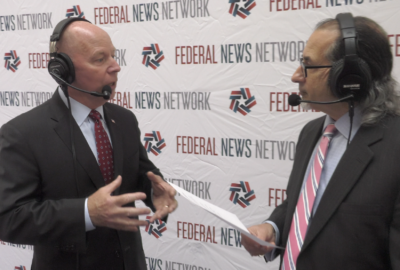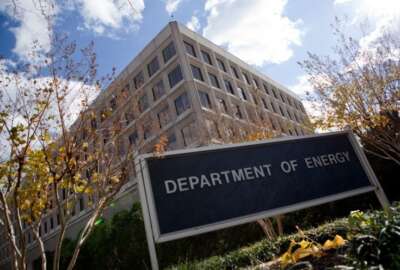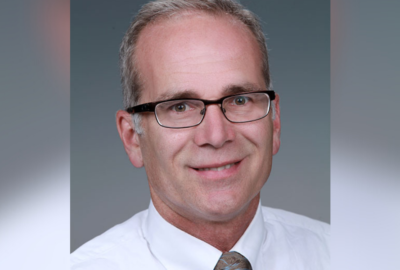The Energy Department directs a prize challenge program to historically underserved groups
A new funding program from the Energy Department aims to enlist low income and underserved communities in finding answers to climate questions. The Inclusive Energy...
Best listening experience is on Chrome, Firefox or Safari. Subscribe to Federal Drive’s daily audio interviews on Apple Podcasts or PodcastOne.
A new funding program from the Energy Department aims to enlist low income and underserved communities in finding answers to climate questions. The Inclusive Energy Innovation Prizes will give challenge winners up to $250,000 for ideas they can develop into clean energy technologies. Joining Federal Drive with Tom Temin with details, the innovation and market transformation advisor for DOE’s water power technologies office, Rukmani Vijayaraghavan.
Interview transcript:
Tom Temin: Mr. Vijayaraghavan, good to have you on.
Rukmani Vijayaraghavan: Thanks.
Tom Temin: So well tell us about this program. This is a challenge prize program, not a grant program. What is the challenge that you are posing here?
Rukmani Vijayaraghavan: Yeah, so this is a prize meant for organizations that are working with disadvantaged communities. And the goal of this prize is to support future efforts to really support clean energy innovation and entrepreneurship in disadvantaged communities. So we want to support organizations that are community centric, that have successfully engaged with disadvantaged communities, those that promote energy, justice, environmental and climate justice, and essentially serve as bridges between DOE and disadvantaged communities that aren’t necessarily aware of or have strong connections to what we do at the Department of Energy.
Tom Temin: Well, if they get a prize, what will they have demonstrated that would be worthy of the prize? Because if you’re looking for, I’m just guessing new technologies, that’s not going to necessarily come from just any old place.
Rukmani Vijayaraghavan: Yeah, this spread is in specifically for technologies. So to participate in the prize, we ask teams to submit essentially an impact statement of around 5,000 words describing who they are, what they do, what they do, and a three minute video. And we have very clear criteria that we use to evaluate these impact statements and decide who would win a prize. So these criteria are based on their experiences and engaging and working with disadvantaged communities, what activities they plan to do with the prize funding, what their long term vision and what the forward impacts are.
Tom Temin: Well, without giving away the store so that people could get a prize from what you say, but can you think of an example of what type of activity and organization receiving a prize might do? Just give us an example.
Rukmani Vijayaraghavan: Yeah, sure. So there are different types of activities we envision. One is we envision universities and colleges that have strong ties to communities, into large numbers of students from underrepresented populations, developing services that for clean energy related incubation, clean energy related entrepreneurship, or we envision community centric organizations that are really working on grassroots innovation related to clean energy in their communities. So it’s really a pretty open ended prize, we really want to hear ideas from communities themselves. But these are some, examples of activities they’ll do. And one thing we really want to emphasize is that we are not just looking to support, not even necessarily looking to support organizations, quote, unquote, deep tech and the nitty gritty of how do organizations that are embedded within large research institutions, but we want to really support those who have ties to the community and have experienced engaging disadvantaged communities.
Tom Temin: We are speaking with Rukmani Vijayaraghavan. She is the innovation and market transformation advisor for the Department of Energy’s Water Power Technologies Office. And I just wanted to ask you, since you are an expert in water power, which I think of as dams and hydroelectric, that doesn’t sound like something that would have a lot of application in urban areas, for example.
Rukmani Vijayaraghavan: So we do hydropower, for sure. But we also support marine energy. And we hope we’ll have applications in both those areas and rural areas and coastal areas or not, you know, rivers, all across the country, really. So hydropower is one of our largest sources of clean energy of, carbon free energy in the US and provides electricity to a number of cities across the country, to a number of small towns. There are also a number of other opportunities in hydropower, for instance, are our most significant, particularly, as we have more renewable energy sources coming online that are more periodic than other farms.
Tom Temin: Not everything is the Hoover Dam, in other words.
Rukmani Vijayaraghavan: Yeah, and marine energy is also something our office supports and funds and this is a newer form of renewable energy that is a little less mature than hydropower or even wind and solar energy. So this is tapping energy from flowing rivers from ocean waves, ocean currents, even tides and harnessing that energy of flowing water in producing electricity. And so we support foundational research, we support applications, support, integration of marine energy with the blue economy, and try to tap into this huge source of renewable energy that we haven’t been able to tap into yet.
Tom Temin: Alright, and I can think of some pretty bad ponds in and around Baltimore that might have algae that could produce a lot of energy. And maybe someday you’ll figure out a way to harness the political hot air, that could produce a lot of energy too, better than it’s doing now. And getting back to grant program. What are the timelines here and what is the total amount you plan to give out by when? And then what happens?
Rukmani Vijayaraghavan: Yeah, so the entries for this prize are due on February 25 2022. And we hope to have announcements and decisions on who the winners are by March. And we will initially give out $2 million. So we anticipate that up to 10. Teams so receive $200,000 Each in cash, and the goal is that these funds would be used to carry out the activities they described in their impact plan. And 12 months after the closing of this phase and the announcements, we’ll bring in entries for a new phase that the 10 winning teams will be eligible to compete in, and in that phase, we will have an additional at least half a million dollars available for teams that have made the most progress towards their goals and shown significant advancements in their activities during the last year with money.
Tom Temin: Vijay Raghavan is the innovation and market transformation advisor for the Department of Energy’s water power Technologies Office. Thanks so much for joining me. Thanks, Tom.
Rukmani Vijayaraghavan: It was a pleasure talking to you.
Copyright © 2025 Federal News Network. All rights reserved. This website is not intended for users located within the European Economic Area.
Tom Temin is host of the Federal Drive and has been providing insight on federal technology and management issues for more than 30 years.
Follow @tteminWFED






